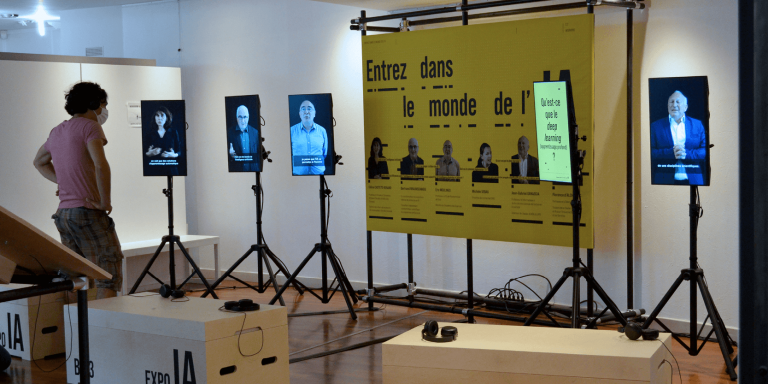
AI strategies are at the heart of the research of Aurélien Garivier, a professor at the Ecole Normale Supérieure de Lyon, a member of UMPA and an associate at LIP. Motivated by the demystification of this discipline, the researcher has been heavily involved in the Enter the AI worldexhibition .
Straddling the line between mathematics and computer science, Aurélien Garivier bridges the gap between the two. ” Computer science has always interested me. My father, a French teacher, had bought a TO8 to type his lessons. I must have been about ten years old and he let me play with it. I had learned a little bit by myself to program, while he didn’t do it at all. I made music and games with it. Aurélien thus developed an ease with the fundamental concepts of computer science and later received a good training in mathematics in preparatory class. His thesis work will combine these two disciplines for the first time. A beautiful course passing through Paris and Toulouse leads the researcher to his current position of professor at the ENS of Lyon.
Aurélien’s current position was created to bridge the gap between two laboratories, on the one hand the UMPA (mathematics laboratory) and on the other hand the LIP (computer science laboratory), around artificial intelligence and machine learning. His role is to animate and coordinate actions on AI.
His work focuses on a specific aspect of AI. “I am especially interested in what is called reinforcement learning and sequential learning. What they have in common is a looped interaction between the data and the person using it to make choices. From the data, we build decisions that condition new observations,” explains Aurélien. To understand this interaction, let’s draw a parallel with a robot that finds itself in a maze.
At the beginning, it knows almost nothing: it only knows what its objective is, for example, to get out of the maze. It will gradually discover its environment and adjust its way of moving to fulfill its objective. Aurélien is interested in the best possible strategies for such a robot and in the impassable limits that no strategy can ever surpass.
“AI is the ability to make an automatic system autonomous, like living beings.
living beings. An AI must be able to perceive its environment (for example with computer
computer vision), act (e.g. with robotics) and have strategies.
have strategies.”
Aurélien is involved in fundamental research, he looks at models that are relatively simple. They are not very realistic but he studies them with great precision. This will allow us, when we are confronted with more complicated models, to draw inspiration from what we have well understood about the simple models.
A gap between theory and practice
At this stage, something may seem inconsistent: computers can already recognize cats by themselves but we still have to study unrealistic models… In reality, it is not inconsistent at all. After a complex history, practice has taken a big lead over theory in AI in recent years. ” The power of deep neural networks and an experimental scientific discovery that needs to be caught up with from a theoretical point of view. We recently understand a little better what is going on, but the theoretical results are unfortunately still quite limited in their practical significance,” says Aurélien. What has made AI progress are ideas of algorithms inspired by the brain (for example with artificial neurons) that work very well and give results. Currently, there is a research effort to understand the real reasons why these methods work and how to optimize them.
A more real picture of AI
Aurélien Garivier is one of the scientific curators of the exhibition Enter the world of AI, alongside Alexei Tsygvintsev. A key role you may not be aware of. “It is necessary to coordinate the discussion between the writers of the texts, the people who design the physical elements of the exhibition and the scientists. Together, we determined the main directions of the exhibition, including demystifying and giving the public a real idea of what AI is,” he explains. AI is a subject on which we hear a lot of talk, especially in the media. Yet progress in the field is driven by academia. “We need scientists to assume their mission towards the public. Explain what the field is, what to fear and what not to fear. Understand that there are a lot of exciting challenges to get involved in.”
A new and interesting experience that brought together people from very different backgrounds and took stock of what is important to know about AI. Far from his usual practice as a researcher, Aurélien was able to see how ideas are transformed into concrete communication tools accessible to everyone. AI is a technology that has taken on new importance and now has a strong impact on our lives. The exhibition presents this powerful tool that it is necessary to understand, far from the
fantasies of science fiction.
Information and reservation: https: //mmi-lyon.fr/
Interview by Nina Gasking
Translated from Exposition « Entrez dans le monde de l’IA » : dépasser les clichés de l’IA









